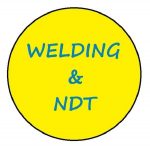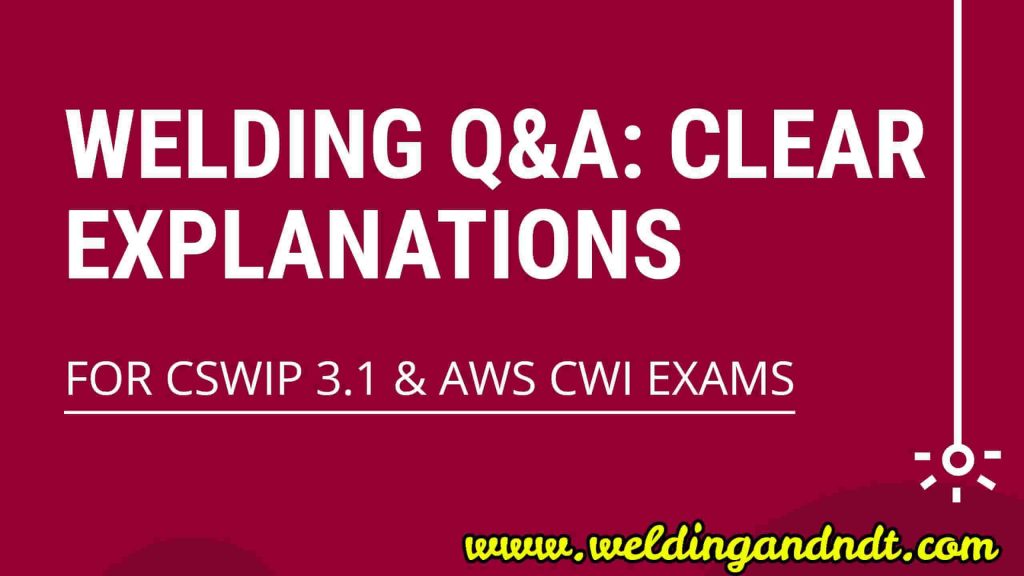Q1. Which of the following welding processes would give the highest heat input when using typical parameters?
- Tungsten Inert Gas welding
- Manual Metal Arc welding
- Submerged Arc welding
- Metal Active Gas welding
(Explanation: The continuous feeding of the electrode and the use of granular flux contribute to sustained and intense heat, making SAW effective for welding thick materials and achieving deep penetration.)
Q2. Autogenous welding refers to what?
- Welding with filler wire
- Mechanised welding
- Welding without filler wire
- Manual welding
(Explanation: Autogenous welding refers to welding without filler wire. In autogenous welding, the fusion of base metals is achieved without use of additional filler material. The weld joint is formed solely by melting and solidifying the edges of the workpieces. This process is commonly used when the base metal itself is sufficient to provide the necessary material for creating a sound weld joint.)
Q3. Synergic welding is associated with which welding process?
- GMAW
- MMAW/SMAW
- GTAW
- SAW
(Explanation: In a synergic welding system, changes to one parameter lead to automatic adjustments in others to maintain an optimal welding condition. It involves a welding power source that automatically adjusts both voltage and wire feed speed in a coordinated or “synergic” manner. Synergic GMAW systems are designed to enhance efficiency and control in the welding operation.)
Q4. In which of the following welding process, Carbon Dioxide gas is used?
- GMAW
- MMAW/SMAW
- GTAW
- SAW
(Explanation: In GMAW, CO2 can be used as the shielding gas, the process is sometimes referred to as MAG (Metal Active Gas) welding because CO2 is not an inert gas. The use of CO2 in GMAW/MAG welding helps protect the weld pool from atmospheric contamination and provides a stable arc for the fusion of metals.
Q5. The term “low hydrogen electrode” is often used for certain electrodes. What type of covering will they have?
- Cellulosic
- Rutile
- Basic
- Acid
(Explanation: The term “low hydrogen electrode” is often associated with electrodes that have a basic covering. These electrodes are designed to deposit weld metal with low levels of hydrogen, which is crucial for preventing hydrogen-induced cracking in the weld metal. Basic-coated electrodes are often used in applications where hydrogen-induced cracking is a concern, such as welding high-strength steels and critical applications.)
Q6. The composition of steel is changed from 0.15% carbon & 0.6% manganese to 0.2% carbon & 1.2% manganese. Might this influence the incidence of:
- Porosity
- Cracking in the weld area
- Undercut for fillet welds
- Lack of root fusion defects
(Explanation: Let’s analyse each potential effect:
- Porosity: Increasing manganese from 0.6% to 1.2% is likely to reduce porosity in the weld because manganese acts as a deoxidizer, lowering oxygen content.
- Cracking in the weld area: Increasing carbon and manganese can influence the hardenability of the steel, potentially making it more susceptible to cracking. Hence, it could increase the risk of cracking, particularly if not properly controlled during welding.
- Undercut for fillet welds: Undercutting is often influenced by welding parameters and the base metal composition. More carbon might slightly increase undercut, but welding parameters and technique also play a significant role in undercutting for fillet welds.
- Lack of root fusion defects: The rise in manganese content is likely to improve root fusion, contributing to better penetration and fusion in the weld.)
Q7. Which of the following alloys is nonmagnetic?
- 4% Chromium Molybdenum
- 12% Chromium
- Austenitic Stainless Steel
- 9% Nickle Steel
(Explanation: Let’s analyse each option:
- 4% Chromium Molybdenum: Alloys with chromium and molybdenum are typically magnetic, and this alloy is no exception.
- 12% Chromium: Chromium alloys are usually magnetic, and the high chromium content in this alloy contributes to its magnetic properties.
- Austenitic Stainless Steel: Austenitic stainless steels, with high nickel content and a face-centered cubic crystal structure, are generally nonmagnetic.
- 9% Nickel Steel: Nickel alloys, like this one with a significant nickel content, are typically nonmagnetic due to the austenitic structure imparted by nickel.
So, while both c & d are considered nonmagnetic, austenitic stainless steel is usually consistently nonmagnetic, and 9% Nickel Steel may show minimal magnetic effects under certain conditions. Hence most appropriate answer will be “Austenitic stainless steel”.)
Q8. Addition of which element in steel increase its toughness at sub-zero temperature?
- Carbon
- Chromium
- Nickel
- Molybdenum
(Explanation: When it comes to toughness at sub-zero temperatures, Nickel is often more prominently associated with this property. Nickel helps maintain ductility and impact resistance even in cold conditions. Molybdenum, indeed, plays a crucial role in improving the toughness of steel, especially at elevated temperatures. It enhances hardenability and strength.)
Q9. Which of the following elements help in improved creep properties at elevated temperature in steel?
- Tungsten
- Manganese
- Molybdenum
- Carbon
(Explanation: Molybdenum improves the creep properties of steel at elevated temperatures by forming stable carbides, inhibiting grain coarsening, and enhancing resistance to deformation through solid solution strengthening.
Molybdenum is like a superhero for steel at high temperatures. It forms special structures that prevent the steel from getting weaker and deforming when it’s really hot. It’s like adding reinforcements to a building, making the steel stronger and more resistant to damage, especially over time at high temperatures.)
Q10. Tensile strength can be increased in steel by:
- Annealing
- Galvanising
- Addition of carbon
- Casting
(Explanation: Carbon is a common alloying element in steel and contributes significantly to its strength. The relationship between carbon content, hardness, and tensile strength in steel is indeed nuanced. Up to a certain point, increasing carbon content in steel tends to increase its tensile strength but excessive carbon can lead to increased hardness and brittleness.
Annealing is a heat treatment process that is often used to improve the ductility and reduce hardness in steel, but it doesn’t directly increase tensile strength).
Q11. Which of the following chemical elements has the greater effect on the hardenability of a steel plate?
- Molybdenum
- Chromium
- Titanium
- Carbon
(Explanation: The hardenability of steel refers to its ability to be hardened through heat treatment, typically by quenching. Among the options provided:
Carbon: Carbon has a significant impact on hardenability. It is a key element in the formation of various hardening phases, such as martensite, during the quenching process. Increasing carbon content generally improves hardenability, but it needs to be within a certain range to avoid excessive brittleness.
Molybdenum, Chromium, Titanium: While these elements can influence the overall properties of steel, their direct effect on hardenability is generally not as pronounced as that of carbon.
In summary, while all the elements listed can contribute to the overall properties of steel, the one with the greater effect on hardenability among the options provided is Carbon.)
Q12. To prevent the hardening and cracking of High Carbon Steel plate during flame cutting, it is advisable to:
- Pre-heat the plate
- Soak the plate in oil
- Cool the plate quickly after cutting
- Increase the cutting Oxygen pressure
(Explanation: Pre-heating the high carbon steel plate before flame cutting helps reduce the temperature gradient between the heated and unheated regions, minimizing the risk of hardening and cracking during the cutting process.)
Q13. Re-crystallization during annealing is used to make steel:
- Softer
- Harder
- Tougher
- Stronger
(Explanation: Annealing, including re-crystallization annealing, is a heat treatment process that promotes the formation of new, strain-free grains in the steel. This results in a softer and more ductile material.)
Q14. On which of the following, you will not be able to perform MPI?
- A low carbon steel butt welded joint
- An Austenitic Stainless steel fillet welded T joint
- A medium carbon steel fillet welded lap joint
- All of the above
(Explanation: Austenitic stainless steel is generally nonmagnetic and may not be well-suited for traditional MPI. Other inspection methods like dye penetrant or ultrasonic testing might be more appropriate.
Q15. SMAW (MMA) welding of low alloy steels is more likely to be performed with?
- Rutile electrodes
- Cellulosic electrodes
- Neutral electrodes
- Basic hydrogen controlled electrodes
(Explanation: Low alloy steels are a category of steels that contain a relatively low percentage of alloying elements compared to high alloy steels. The term “low alloy” is relative and typically refers to steels where the total alloying elements constitute less than 5% of the steel’s composition.
For low alloy steels, The basic hydrogen controlled electrodes are often preferred because they provide good mechanical properties and are effective in preventing the formation of hydrogen-induced cracking, which is a common concern when welding low alloy steels. Example of basic hydrogen controlled electrodes are;
- E7018: This is a commonly used basic hydrogen-controlled electrode for welding carbon and low alloy steels. It provides good mechanical properties and is known for its versatility.
- E7016: Another basic hydrogen-controlled electrode suitable for welding carbon and low alloy steels. It is often used in applications where higher penetration is required.
- E7015: This electrode is also basic-coated and low hydrogen. It is used for welding carbon and low alloy steels in various applications.
Q16. In MMA welding (SMAW) what parameter is used to control the penetration into the base material?
- Voltage
- Welding speed
- Iron powders in the coating
- Current
(Explanation: Current plays a significant role in controlling the depth of penetration during welding. Increasing the current generally leads to greater heat input and deeper penetration, while decreasing the current can result in shallower penetration.)
Q17. Consumable electrode, flux shielded, manual process is a description of which welding process?:
- FCAW
- SAW
- GTAW/TIG
- SMAW/MMAW
(Explanation: The SMAW (MMAW) electrodes are flux shielded and gets consumed during the welding and it is a manual process.)
Q18. Why high O.C.V. is required for MMA welding?
- To initiate the arc
- To obtain penetration
- To avoid lack of fusion
- MMA welding does not have a high O.C.V.
(To strike an arc, a relatively high voltage is required to generate a spark between the electrode and base metal. This is known as the open circuit voltage (OCV) and is typically ~50-~90V.
The arc is initiated when the electrode is brought close to the workpiece, and the high O.C.V. helps to establish a stable arc by overcoming the resistance between the electrode and the workpiece.)
Q19. Which of the following butt-weld preparations is generally most susceptible to ‘lack of side wall fusion’ during MMA welding?
- A ‘U’ preparation
- A ‘V’ preparation
- A ‘double V’ preparation
- Lack of side wall fusion does not exist with MMA
(Explanation: A groove with a U-shaped profile is more susceptible to ‘lack of side wall fusion’ during MMA welding. The U-shaped groove makes it challenging to achieve proper fusion along the sidewalls of the joint.)
Q20. Which arc welding process utilizes a non-consumable electrode?
- MIG
- TIG
- MMA
- All of the above
(Explanation: In TIG welding, a tungsten electrode is used to generate the arc which produces the necessary heat for welding. However, the electrode is not consumed during welding. If required, additional filler metal is used.)

